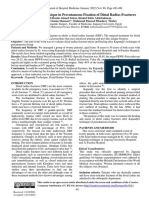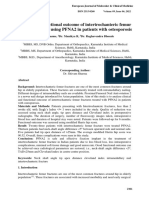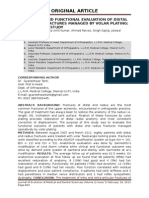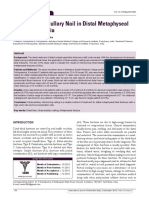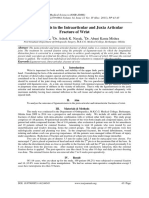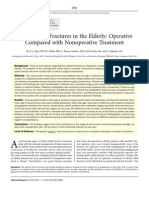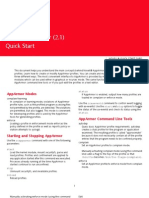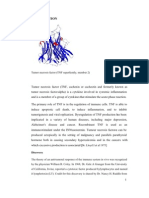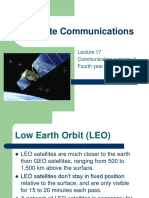Outcomes of Treatment of Intra-Articular Distal Radius Fractures With Volar Locked Plates in Patients Above 50 Years
Outcomes of Treatment of Intra-Articular Distal Radius Fractures With Volar Locked Plates in Patients Above 50 Years
Copyright:
Available Formats
Outcomes of Treatment of Intra-Articular Distal Radius Fractures With Volar Locked Plates in Patients Above 50 Years
Outcomes of Treatment of Intra-Articular Distal Radius Fractures With Volar Locked Plates in Patients Above 50 Years
Original Title
Copyright
Available Formats
Share this document
Did you find this document useful?
Is this content inappropriate?
Copyright:
Available Formats
Outcomes of Treatment of Intra-Articular Distal Radius Fractures With Volar Locked Plates in Patients Above 50 Years
Outcomes of Treatment of Intra-Articular Distal Radius Fractures With Volar Locked Plates in Patients Above 50 Years
Copyright:
Available Formats
Volume 9, Issue 11, November – 2024 International Journal of Innovative Science and Research Technology
ISSN No:-2456-2165 https://doi.org/10.38124/ijisrt/IJISRT24NOV129
Outcomes of Treatment of Intra-Articular
Distal Radius Fractures with Volar Locked
Plates in Patients Above 50 Years
Muhsin Dursun
PhD. Physician, Ortadoğu Private Hospital,
Department of Orthopedics and Traumatology, Adana, Turkey.
https://orcid.org/0000-0002-4024-5059
Abstract:- I. INTRODUCTION
Objective: Fractures of the distal end of the radius make up one
Outcomes of the treatment of intra-articular distal sixth of the patients presenting with fractures at the
radius fractures seen in patients above 50 years with emergency units.1 When the distribution of age related
volar locked plates were evaluated. fractures are studied, there are two age groups where
incidence is increased. While the first group is made of
Study design: physically active children between 5 and 10 years of age,
Twenty Eight patients (8 female and 20 male) the second group is made of elderly patients between 50
treated in our clinic with volar locked plates because of and 69 years of age leading less active lives. 2 The
intra-articular distal radius fractures were evaluated mechanism of injury is usually falling on open hand, and
after a 17-month (range 8-30 months) follow-up. Mean this mechanism of injury is particularly valid for
age of the patients was 45.2 (range 50-64) years. osteoporotic patients with reduced bone quality. 3,4 Because
Fractures were classified according to Frykman and AO the young population is open to high energy injuries, there
classifications. According to the Frykman classification, is a high probability of multi-piece and displaced fractures.
2 patients had type 3 (7%), 1 patient had type 4 (5.5%), On the other hand, comminuted intra-articular fractures are
14 patients had type 7 (50%) and 11 patients had type 8 more probable in elderly patients due to the reduced bone
(37.5%) fractures. According to the AO classification, 6 quality. These fractures can be in the form of open
patients had B2 (23.5%), 4 patients had C1 (14%), 11 fractures, but can also be associated with tendon ruptures
patients had C2 (37.5%) and 7 patients had C3 (25%) and neurovascular injuries.5
fractures. All patients were evaluated clinically and
radiologically. Clinical outcomes of the patients were These are important fractures because their treatment
evaluated using Gartland and Werley’s evaluation outcomes affect daily functions of individuals. Fracture
scores and DASH-T scores. Radiologic outcomes were type, age, general status, physical and cognitive capacity,
evaluated according to the radiologic evaluation criteria additional diseases, compliance to treatment and
modified by Steward et al. expectations of the patient should be taken into
consideration in planning the treatment,6
Results:
According to the evaluation scores of Gartland and The aim of treatment is to obtain anatomic reduction
Werley, 20 patients yielded excellent (72%), 5 patients as well as maintain the achieved reduction while the
good (18%) and 3 patients moderate (10%) results. fracture heals.7 Age related reduction in bone quality leads
Mean DASH-T score of the patients was 34 (range 31 to to implant failure and loss of reduction and iatrogenic non-
40). unions. Use of constant angle volar locked plates is an
important treatment modality to overcome this
Conclusions: complications.7
Treatment of intra-articular distal radius fractures
seen above 50 years of age with volar locked plates is an In this study, patients with intra-articular distal radius
efficient and safe method. Use of volar locked plates fractures aged above 50 years and treated with constant
reduces the complication risk of reduction loss and need angle volar locked plates were evaluated regarding
for grafts in osteoporotic fractures. anatomic, radiologic and clinical outcomes, and the
influence of treatment outcomes on the daily chores and
Keywords:- Fractures Of The Radius; Forearm Injuries; social lives of the patients were studied.
Colles Fractures.
IJISRT24NOV129 www.ijisrt.com 760
Volume 9, Issue 11, November – 2024 International Journal of Innovative Science and Research Technology
ISSN No:-2456-2165 https://doi.org/10.38124/ijisrt/IJISRT24NOV129
II. MATERIALS AND METHODS carpi radialis tandon. The pronator quadratus muscle was
dissected from the radial insertion site. The fracture was
Twenty-eight distal radius fractures of 28 patients exposed. İntra-articular fractures were indirectly reduced
aged above 50 years presenting with intra-articular distal and a volar constant angle plate was adapted. First, one
radius fractures at the emergency service of our clinic unlocked cortical screw was screwed to the proximal
between February 2006 and April 2008 were fragment by keeping the fracture at the reduced position
retrospectively evaluated. Eight patients (29%) were female and the plate was aimed to have a supporting effect on the
and 20 (71%) were male. Female: male ratio was 1:2.5. distal fragment. Then a constant angle locked screw was
Mean age was 54.2 years (range 50 to 64 years). Twenty- placed at the part compatible with the subchondral region
two (78%) fractures were on the right extremity and 6 with the fracture in the reduced position. A fluoroscopic
(22%) were on the left extremity. Four (14%) of the control was carried out and the reduction of the fracture,
fractures were type I open fractures according to the position of the plate and the relationship of subchondral
Gustilo-Anderson classification. screws with the joint were assessed. Following this,
proximal metaphysis screws were sent as to hold the dorsal
In addition to distal radius fractures, there were pieces for supplemental stability. At least 2 locked cortical
intertrochanteric femur fractures in 2 patients and an screws were added to the proximal fragment and a repeat
olecranon fracture in 1 patient. fluoroscopic control was made. The tourniquet was opened
and bleeding control was made. The pronator quadratus
Histories were taken primarily from patients muscle was sutured so as to cover the plate. Subcutaneous
presenting with distal radius fractures at the emergency tissue was sutured with a 4/0 absorbable suture. The skin
service. Patients underwent physical examination and was closed with a 4/0 nonabsorbable suture and an elastic
antero-posterior and lateral X-rays of the wrists were bandage was applied (Figure 1 and 2).
routinely taken. In patients thought to have additional
pathologies, examinations directed at these pathologies On the first postoperative day, all patients were started
were added. on finger movement aperture exercises and fore arm
pronation-supination exercises at tolerable levels. At the
Distal radius fractures of all patients underwent closed end of the first week, the patients started wrist exercises.
reduction and fixation with circular casts and control X-
rays were taken. X-rays were evaluated for radial heights, Sutures of all patients were taken on day 15. Until the
radial inclination, palmar slope and articular discordance end of the eighth week finger, wrist and fore arm
before and after reduction. Taking into consideration the movements were progressively increased with weekly
stability criteria determined by La fontaine et al.8, surgical controls.
treatment was decided for unstable fractures and the
patients were included in the study group. Patients were followed clinically and radiologically.
Patients with adequate follow-up were called for their last
Frykman9 and AO10 classifications were used in the controls. Mean follow-up at last controls was 17 months
evaluation of fractures. Patients included in the study had 2 (range 8 months to 30 months). Clinical outcomes were
type 3 fractures (7%), 1 type 4 fracture (5.5%), 14 type 7 evaluated with the evaluation score of Gartland and
fractures (50%) and 11 type 8 fractures (37.5%) according Werley11 (Table 1) and DASH-T score12 (Table 2).
to the Frykman classification, and 6 type B2 fractures Radiologic outcomes were evaluated according to the
(23.5%), 4 type C1 fractures (14%), 11 type C2 fractures radiologic evaluation criteria modified by Steward et al.13
(37.5%) and 7 type C3 fractures (25%) according to the AO (Table 3).
classification.
Among the patients presenting at our clinic with distal
radius fractures, 8 were operated on during the first 3 days,
14 between days 3 and 7, and 6 between days 7 and 16. The
mean interval between the fracture and surgery was 5.3
days (range 2 to 41 days). Surgical Technique:
Surgical Technique
General anesthesia was applied to 6 patients,
supraclavicular block to 8 patients and axillary block to 14
patients. Distal radii of all patients were operated on under
a tourniquet. The patients were taken to the operating room
and laid in a supine position. Following anesthesia,
prophylactic 1 gr Cefazolin sodium was administered
intravenously before the tourniquet. Following appropriate
Fig 1: Anteroposterior and Lateral View of 58 Years Old
cleaning and draping, the fore arm was placed on the hand
Male Patient’s Distal Radial Fracture
table with the wrist at a 90 degree flexion. With a volar
longitudinal incision, an entrance was made over the flexor
IJISRT24NOV129 www.ijisrt.com 761
Volume 9, Issue 11, November – 2024 International Journal of Innovative Science and Research Technology
ISSN No:-2456-2165 https://doi.org/10.38124/ijisrt/IJISRT24NOV129
wound debridement on day 12 and use of oral antibiotics.
In one patient operated on day 41 following fracture and
healing with shortening, there were findings of pressure on
the median nerve during follow-up and the implant was
removed at the end of the 8th month. The symptoms
improved following removal of the implant. Reflex
sympathetic dystrophy developed in 5 patients. Significant
improvement was obtained with physical therapy together
with opposite bath applications and use of Calcitonin 200
IU as a nasal spray for 2 months. No complications like
tendon ruptures and tenosynovitis were seen in any patient.
Postoperative arthritis was not encountered clinically or
radiologically, but the follow-up was short.
Fig 2: Postoperative Sixth Months Anteroposterior and IV. DISCUSSION
Lateral View of the Same Patient’s Wrist
The incidence of distal radius fractures has increased
III. RESULTS due to the widespread use of motor vehicles, regular sports
activities and increased life expectancy. The aims in the
Finally, complete content and organizational editing treatment of intra-articular distal radius fractures are
before formatting. Please take note of the following items achievement of maximal function, maintenance of
when proofreading spelling and grammar: According to the movement aperture, limitation of posttraumatic arthritis and
clinical evaluation criteria of Garland and Werley, excellent prevention of complications.12 In order to achieve these
results were obtained in 20 (72%) of 28 distal radii, good therapeutic aims, an appropriate reduction should be
results in 5 (18%) and moderate results in 2 (10%). Mean obtained and preserved until the fracture heals and a good
DASH-T value of the patients evaluated with the DASH-T rehabilitation program should be carried out for the
score was 34 (range 31 to 40). restoration of movement and strength.
At the last follow-up, wrist and fore arm movement In addition to the necessary criteria for an acceptable
aperture values were as follows: 70º (range 50º to 90º) reduction in intra-articular distal radius fractures, there is
dorsiflexion, 60º (range 40º to 90º) palmar flexion, 28º still controversy about the optimal techniques to be applied
(range 20º to 45º) unlar deviation, 20º (range 10º to 35º) in order to obtain this reduction and maintain its continuity.
radial deviation, 75º (range 60º to 90º) pronation and 80º Gartland and Werley have shown that four components of
(range 75º to 90º) supination. distal radius fractures should be corrected in order to obtain
good functional results; 1) radial shortening, 2) radial
With the Steward’s scoring system carried out for inclination, 3) dorsal slope and 4) discordance of distal
radiologic evaluation, excellent results were obtained in 19 radioulnar joint.14 The generally accepted opinion is that
fractures (68%), good results in 7 (25%) and moderate good functional results can be obtained by restoring the
results in 2 fractures (7%). neutral length of the radius, and by achieving a radial
inclination of more than 0 degree, a volar slope between 0
In the radiologic evaluation of the fractures, mean and 5 degrees, an articular stepping of less than 2 mm,
preoperative radial height was 0 mm [range (-16) to 6], stable relationships between carpal joints and decreased
mean postoperative radial height was 14 mm [range 6 to distal radioulnar joint instability. Although basic
25], mean preoperative radial inclination was 4º [range (-8º) extraarticular criteria (radial height, radial inclination, volar
to 10º], mean postoperative radial inclination was 22º slope) are important, the most important criterion required
[range 10º to 28º], mean preoperative palmar slope was -10º for successful results has been accepted to be intra-articular
[range (-20º) to 5º] and mean postoperative palmar slope reconstruction, that is correct restoration of the joint
was 4º [range (-5º) to 10º]. İntra-articular stepping and surface.4,14,15
gapings were anatomically restored with the exception of 1
patient. There was a 3-mm intra-articular stepping only in 1 Currently, the treatment of fractures of the distal end
patient. of the radius is planned regarding the stability of the
fracture. La Fontaine et al. have identified criteria for
Mean time needed for the patients to perform their determining the stability the fracture. According to the
normal daily functions was found to be 65 days (range 42 criteria of La Fontaine et al., stable fractures are non-
to 105 days). displaced or mildly displaced fractures without dorsal
fragmentation and seen in young patients. 8 In these patients
During surgery no radial artery injury, median nerve treatment with a cast is usually sufficient. On the other
injury or complications related with the tendinous hand, different treatment modalities should be tried in
structures dissected during exploration were encountered in unstable fractures of the distal end of the radius. An
any patient. There was a wound site infection in one patient unstable fracture should have at least three of the following
during the early postoperative period and was treated with criteria: a dorsal inclination of more than 20 degrees during
IJISRT24NOV129 www.ijisrt.com 762
Volume 9, Issue 11, November – 2024 International Journal of Innovative Science and Research Technology
ISSN No:-2456-2165 https://doi.org/10.38124/ijisrt/IJISRT24NOV129
fracture formation, fragmentation of dorsal metaphysis, additional casts in the postoperative period and started
radiocarpal intra-articular spreading, presence of an unlar active movement aperture exercises of the wrist and elbow
styloid fracture and patient age above 60 years.8 on the seventh postoperative day.
Intra-articular distal radius fractures which usually Another important point is that constant angle volar
occur following high energy trauma in young adults occur locked plates provide indirect reduction. In our technique, it
as a result of low energy trauma due to decreased bone is possible to provide reduction between the proximal and
quality in patients above 50 years of age. Distal radius distal fragments by using the buttress effect of the plate
fractures occurring as a result of a simple fall on open hand after the adaptation of the anatomically compatible constant
can be treated with closed reduction and cast angle volar locked plate to the proximal fragment with one
immobilization most of the time. Although numerous unlocked cortical screw following indirect reduction of
fixation methods have been described for patients that intaarticular fragments with the aid of carpal bones and
cannot undergo closed reduction or are decided to be carpal ligaments and consequently stabilization of the
unstable following closed reduction, there is still no fracture by placing locked screws to the screw holes
consensus about the appropriate treatment. Many treatment matching the subchondral region of the distal fragment with
and fixation methods have been described in the literature the use of these plates.
ranging from percutaneous pinning together with closed
reduction to arthroscopically supported open reduction and Because previous plates did not have these
internal fixation technique with multiple plates (fragment qualifications, the use of plate screw was not recommended
specific fixation). Successful results can be obtained with in osteoporotic elderly patients. 24 According to our current
the defined techniques in many distal radius fractures. knowledge, osteoporosis of the fracture is among the
Nevertheless, treatment of patients with reduced bone indications for the use of plate screws. The study by Orbay
quality is important. Particularly, the treatment method to and Fernandez confirming this observation of ours has also
be chosen in intra-articular distal radius fractures in patients reported success with the treatment performed by the volar
above 50 years should allow a more rigid fixation. constant angle locked plate system in radius fractures
occurring in the setting of osteoporosis in patients aged 75
There are reports recommending avoidance of open years or above.24
reduction internal fixation in the presence of intra-articular
fractures with severe osteoporosis in the elderly. This was Clinical evaluation of our patients at the end of the
concluded due to the frequent complications like implant study has revealed excellent results in 20 of 28 distal radii
failure, iatrogenic non-union and reflex sympathetic (72%), good results in 5 (18%) and moderate results in 3
dystrophy in these patients.16,17,18 (10%), according to the clinical evaluation criteria of
Gartland and Werley. Mean DASH-T value of the patients
Lauber and Pfeiffer have published the results of 117 evaluated with the DASH-T scoring system was 34 (range
cases with distal radius fractures they treated in 1984, and 31 to 40). These results are similar to those in the literature.
have reported loss of reduction in 12% of cases, permanent Radiologic evaluation of the patients according to
intra-articular stepping or gaping in 50% of cases and Steward’s radiologic scoring system has revealed excellent
failure to restore extra-articular anatomy in approximately results in 19 fractures (68%), good results in 7 (25%) and
2/3 of cases and permanent joint pain in 60% of cases. 19 moderate results in 2 (7%). Thus, clinical and radiologic
Again in 1984, Letsch et al. have evaluated 124 cases scores were found to show compatibility.
treated with a 3.5-mm T plate through dorsal and volar
interventions, and have concluded that these implants are V. CONCLUSIONS
not suitable fixation devices in osteoporotic fractures and in
fractures with large defects due to induction of secondary The aims in the treatment of distal radius fractures are
reduction losses.20 providing anatomic restoration, maintenance of the
restoration until the fracture heals and allowing movement
Successful results have been reported with the use of aperture and function by starting early rehabilitation. Rigid
constant angle volar locked plates in the last decade.21,22,23 fixation is required particularly in patients with intaarticular
It was aimed to reduce radial shortness and prevent distal radius fractures aged 50 years and above because of
secondary reduction losses, maintain palmar tilt by reduced bone quality. Constant angle volar locked plates
restoration and reduce the need for grafting by supporting are suitable materials for the fixation of these fractures. The
the subchondral region with distal locked screws and pegs use of constant angle volar locked plates is associated with
located in the design of volar constant angle plates and by low complication rates.
placing a locked screw in the proximal of the fracture. With
the exception of our patient with a residual 3-mm stepping As a result of our study, the use of constant angle
in the joint, anatomic joint restoration was realized in all volar locked plates in the treatment of intra-articular distal
patients by relieving radial shortening and correcting radius fractures with low bone quality was shown to be an
palmar tilt, and none of our patients developed secondary effective treatment method. Reliability of this method was
reduction loss. Also, none our patients required grafting. supported by the absence of secondary reduction losses and
Another important point is that this plate system allows favorable joint movements and good clinical and radiologic
earlier movement. We monitored our patients without outcomes. We think that this method can be used as a
IJISRT24NOV129 www.ijisrt.com 763
Volume 9, Issue 11, November – 2024 International Journal of Innovative Science and Research Technology
ISSN No:-2456-2165 https://doi.org/10.38124/ijisrt/IJISRT24NOV129
reliable method in patients with low bone quality planned [16]. Hastings H 2nd, Leibovic SJ: Indications and
for surgery. techniques of open reduction. İnternal fixation of
distal radius fractures. Orthop Clin North Am
REFERENCES 1993,24(2):309-26.
[17]. Jupiter JB, Lipton H: The operatif treatment of
[1]. Jupiter JB. Fractures Of The Distal End Of The Intraarticular fractures of the distal radius. Clin
Radius. J Bone Joint Surg. Am. 1991; 73(A): 461- Orthop 1993,292:48-61.
469.. [18]. Arora R, Roth T, Kralinger F,Blauth M: A
[2]. Bradway JK, Amadio PC. Open reduction and Representative Case of Osteoporotic Distal Radius
internal fixation of displaced, comminuted Fracture. J Orthop Trauma 2008; 22: 116-120.
intraarticular fractures of the distal end of the radius. [19]. Lauber P, Pfeiffer KM: Open osteosynthesis of
J Bone Joint Surg 1989; 71(A): 839. distal radius fractures. Results and long-term follow-
[3]. Cooney WP,Linscheid RL, Dobyns JH: Fractures up. Unfallheilkunde 1984, 87(5):185-95.
and dislocation in wrist: Rockwood and Green’s [20]. Letsch R, Schmit-Neuerburg KP, Towfigh H:
Fractures in adults. 3 th edt. Rockwood CA, Green Indications and results of plate osteosynthesis of the
DP, Bucholz RW (Eds). JB Lippincott co. distal radius. Langenbecks Arch Chir 1984,
Newyork., Volume-I, Chapter 8. P:563-638. 364:363-8.
[4]. Knirk JL, Jupiter JB. Intra-articular fractures of the [21]. Willis AA, Kutsumi K, Zobitz ME, Cooney WP:
distal end of the radius in young adults. J Bone Joint Internal Fixation of Dorsally Displaced Fractures of
Surg 1986; 68-A(5): 647-59. the Distal Part of the Radius. A Biomechanical
[5]. Kozin S.H, Wood M.B. Early soft tissue Analysis of Volar Plate Fracture Stability. J Bone
complications after fractures of the distal part of the Joint Surg Am 2006, 88: 2411-2417.
radius. J Bone Joint Surg 1993 ; 75A: 144-153. [22]. Chung KC, Watt AJ, Kotsis SV, Margaliot Z:
[6]. Short WH, Palmer AK, Wernwr FW: A Treatment of Unstable Distal Radial Fractures with
biomechanical study of distal radial fractures. J the Volar Locking Plating System. J Bone Joint Surg
Hand Surg 1987; 12A: 529-534. Am 2006, 88: 2687-94.
[7]. Palmer AK. Fractures of the distal radius. Operative [23]. Taylor KF, Parks BG, Segalman KA:
Hand Surgery ; 3th edition. Churchill Livingstone, Biomechanical Stability of a Fixed-Angle Volar
1991;929-941. Plate Versus Fragment-Specific Fixation System:
[8]. La Fontaine M, Hardy D, Delience P.H. Stability Cyclic Testing in a C2-Type Distal Radius Cadaver
assessment of distal radius fractures. Injury 1989; Fracture Model. J Hand Surg 2006; 31A: 373-378.
20: 208-210. [24]. Orbay JL, Fernandez DL: Volar fixed-angle plate
[9]. Frykman G, Tooma GS, Boyka K, Henderson R. fixation for unstable distal radius fractures in the
Comparison of eleven external fixators for treatment elderly patient. J Hand Surg 2004; 29-A(1):96-102.
of unstable wrist fractures. J Hand Surg 1989; 14A :
247-254.
[10]. Fernandez DL: Geissler WB: Treatment of displaced
articuler fractures of the radius. J Hand
Surg1991,16-a(3):375-84.
[11]. Gartland JJ Jr, Werley WC. Evaluation of healed
Colles’ fractures. J Bone Joint Surg 1951; 33-A:
895-907.
[12]. Hanel DP. Treatment of intraartiküler fractures. In
Trumble TE (Ed) Hand Surgery Update. Hand,
Elbow and Shoulder 3rd ed. American Society for
Surgery of the Hand, Rosemont,2002; pp : 105-121.
[13]. Herrera M, Chapman CB, Roh M, Strauch RJ,
Rosenwasser MP: Treatment of unstable distal
radius fractures with cancellous allograft and
external fixation. J Hand Surg 1999, 24-A(6):1269-
78.
[14]. Jones KG: Colles’ fracture. J Arkansas Med Soc
1976; 73: 244-247
[15]. Weber S.C, Szabo R.M. Severely comminuted distal
radial fracture as an unsolved problem:
Complications associated with external fixation and
pins and plaster techniques. J Hand Surg 1986; 11A:
157-165.
IJISRT24NOV129 www.ijisrt.com 764
You might also like
- Measuring Compliance With The 15-Minute City Concept-State-Of-The-ArtDocument21 pagesMeasuring Compliance With The 15-Minute City Concept-State-Of-The-ArtVasilisNo ratings yet
- SMART VocabularyDocument49 pagesSMART VocabularyNidraf Gaming0% (1)
- Open Reduction and Internal Fixation of Fractures of The Radial HeadDocument5 pagesOpen Reduction and Internal Fixation of Fractures of The Radial Headjeremy1roseNo ratings yet
- Paper 4. Study of Intra-Articular Distal End Radius EJMCMDocument9 pagesPaper 4. Study of Intra-Articular Distal End Radius EJMCMNaveen SathyanNo ratings yet
- Utility and Outcomes of Locking Compression Plates in Distal Femoral FracturesDocument7 pagesUtility and Outcomes of Locking Compression Plates in Distal Femoral FractureskhusnulNo ratings yet
- Journal Homepage: - : IntroductionDocument5 pagesJournal Homepage: - : IntroductionIJAR JOURNALNo ratings yet
- A Study On Management of Bothbones Forearm Fractures With Dynamic Compression PlateDocument5 pagesA Study On Management of Bothbones Forearm Fractures With Dynamic Compression PlateIOSRjournalNo ratings yet
- Assesment of Functional Outcome of Dual Plating For Comminuted Distal Femur FractureDocument13 pagesAssesment of Functional Outcome of Dual Plating For Comminuted Distal Femur FractureIJAR JOURNALNo ratings yet
- Distal Femur Fractures Fixation by Locking Compression Plate-Assessment of Outcome by Rasmussens Functional Knee ScoreDocument7 pagesDistal Femur Fractures Fixation by Locking Compression Plate-Assessment of Outcome by Rasmussens Functional Knee ScoreIJAR JOURNALNo ratings yet
- Evaluation of Functional Outcome After Plate Fixation of Midshaft Fracture of ClavicleDocument4 pagesEvaluation of Functional Outcome After Plate Fixation of Midshaft Fracture of ClavicleSonendra SharmaNo ratings yet
- Outcomes For Late Presenting Lateral Condyle Fracture Oof Humerus in ChildrenDocument8 pagesOutcomes For Late Presenting Lateral Condyle Fracture Oof Humerus in ChildrenShilu ShresthaNo ratings yet
- Gupta 2002Document5 pagesGupta 2002Vinay VivekNo ratings yet
- Supracondylar Fracture Femur Treated With Intramedullary Nail - A Prospective Study of 20 CasesDocument6 pagesSupracondylar Fracture Femur Treated With Intramedullary Nail - A Prospective Study of 20 CasesInternational Organization of Scientific Research (IOSR)No ratings yet
- A Study of Functional Outcome in Three Column Fixation of Complex Tibial Plateau FracturesDocument5 pagesA Study of Functional Outcome in Three Column Fixation of Complex Tibial Plateau FracturesIJAR JOURNALNo ratings yet
- JurnalDocument4 pagesJurnalBagas WidhiarsoNo ratings yet
- 223654-Article Text-546414-1-10-20220403Document6 pages223654-Article Text-546414-1-10-20220403Christopher Freddy Bermeo RiveraNo ratings yet
- Journal Homepage: - : Manuscript HistoryDocument8 pagesJournal Homepage: - : Manuscript HistoryIJAR JOURNALNo ratings yet
- Surgical Treatment of Dorsal Perilunate Fracture-DislocationsDocument7 pagesSurgical Treatment of Dorsal Perilunate Fracture-DislocationsJuanHoyosNo ratings yet
- Open Reduction and Internal Fixation in Proximal Humerus Fractures by Proximal Humerus Locking Plate: A Study of 60 CasesDocument6 pagesOpen Reduction and Internal Fixation in Proximal Humerus Fractures by Proximal Humerus Locking Plate: A Study of 60 CasesDian Putri NingsihNo ratings yet
- Study On Functional Outcome of Bimalleolar Ankle FDocument8 pagesStudy On Functional Outcome of Bimalleolar Ankle Fbhushan adhariNo ratings yet
- 08 Subasi NecmiogluDocument7 pages08 Subasi Necmiogludoos1No ratings yet
- Syndesmotic Screw Removed Verusus Retained: A Comparative Functional AnalysisDocument4 pagesSyndesmotic Screw Removed Verusus Retained: A Comparative Functional AnalysisSarath KumarNo ratings yet
- Percutaneaus Kirschner-Wire Fixation For Displaced Distal Forearm Fractures in ChildrenDocument5 pagesPercutaneaus Kirschner-Wire Fixation For Displaced Distal Forearm Fractures in ChildrennaluphmickeyNo ratings yet
- Treatment of Medial Epicondyle Fracture Without Associated Elbow Dislocation in Older Children and AdolescentsDocument7 pagesTreatment of Medial Epicondyle Fracture Without Associated Elbow Dislocation in Older Children and AdolescentsRahma HanifaNo ratings yet
- To Evaluate The Functional Outcome of Volar Plating in Distal End Radius FracturesDocument11 pagesTo Evaluate The Functional Outcome of Volar Plating in Distal End Radius FracturesIJAR JOURNALNo ratings yet
- 27 JMSCRDocument6 pages27 JMSCRManiDeep ReddyNo ratings yet
- Tan2012 PDFDocument10 pagesTan2012 PDFdebyanditaNo ratings yet
- Percutaneous Endoscopic Decompression Via Transforaminal Approach For Lumbar Lateral Recess Stenosis in Geriatric PatientsDocument7 pagesPercutaneous Endoscopic Decompression Via Transforaminal Approach For Lumbar Lateral Recess Stenosis in Geriatric PatientsAmina GoharyNo ratings yet
- Review of Intramedullary Interlocked Nailing in Closed & Grade I Open Tibial FracturesDocument4 pagesReview of Intramedullary Interlocked Nailing in Closed & Grade I Open Tibial FracturesInternational Organization of Scientific Research (IOSR)No ratings yet
- Functional Outcome of Displaced Clavicle Fracture Treated by Intramedullary Nailing: A Prospective StudyDocument9 pagesFunctional Outcome of Displaced Clavicle Fracture Treated by Intramedullary Nailing: A Prospective StudyIJAR JOURNALNo ratings yet
- EJMCM Volume 9 Issue 6 Pages 2361-2368Document8 pagesEJMCM Volume 9 Issue 6 Pages 2361-2368ManikyaRameshNo ratings yet
- Gyaneshwar Tonk-Anatomical and Functional EvaluationDocument11 pagesGyaneshwar Tonk-Anatomical and Functional EvaluationchinmayghaisasNo ratings yet
- Bicondylar Tibial PlateauDocument7 pagesBicondylar Tibial PlateauMin Banyar AungNo ratings yet
- Surgical Treatment of Intra-Articular Fractures of The Distal Part of The HumerusDocument9 pagesSurgical Treatment of Intra-Articular Fractures of The Distal Part of The HumerusdrarunlalNo ratings yet
- MJCU_Volume 86_Issue September_Pages 2149-2158Document10 pagesMJCU_Volume 86_Issue September_Pages 2149-2158Mrat Kyaw KhineNo ratings yet
- Conservative Versus Surgical Management of Intra-Articular Fractures of Distal End of Radius: A Comparative Clinical StudyDocument10 pagesConservative Versus Surgical Management of Intra-Articular Fractures of Distal End of Radius: A Comparative Clinical StudyAnonymous OJELaiw2No ratings yet
- Treatment Distal Radius Fracture With Volar Buttre PDFDocument5 pagesTreatment Distal Radius Fracture With Volar Buttre PDFZia Ur RehmanNo ratings yet
- Nrutik Paper 22Document6 pagesNrutik Paper 22Nrutik PatelNo ratings yet
- JSES Outcomes of nonoperative management of displaced olecranon fractures in medically unwell patientsDocument5 pagesJSES Outcomes of nonoperative management of displaced olecranon fractures in medically unwell patientsDenisse LoyaNo ratings yet
- Use of Intramedullary Nail in Distal Metaphyseal Fractures of TibiaDocument4 pagesUse of Intramedullary Nail in Distal Metaphyseal Fractures of TibiaTanay BiswasNo ratings yet
- Clinicoradiological and Functional Outcomes of Lisfranc Injuries Managed by Different Treatment Modalities in A Tertiary Care CentreDocument7 pagesClinicoradiological and Functional Outcomes of Lisfranc Injuries Managed by Different Treatment Modalities in A Tertiary Care CentreIJAR JOURNALNo ratings yet
- Functional Outcome of Surgical Management of Floating Knee Injuries in Adults (Ipsilateral Femoral and Tibia Fractures) and Its Prognostic IndicatorsDocument4 pagesFunctional Outcome of Surgical Management of Floating Knee Injuries in Adults (Ipsilateral Femoral and Tibia Fractures) and Its Prognostic IndicatorsManiDeep ReddyNo ratings yet
- Fractures of Distal End of Radius: A Study On Fracture Reduction and Stable FixationDocument5 pagesFractures of Distal End of Radius: A Study On Fracture Reduction and Stable Fixationsanjay chhawraNo ratings yet
- Fracturas y Luxoofracturas Tratadas Con Plca PhilosDocument6 pagesFracturas y Luxoofracturas Tratadas Con Plca PhilosElmer NarvaezNo ratings yet
- Long Term Outcome of Isolated DiaphysealDocument5 pagesLong Term Outcome of Isolated DiaphysealVIDevAryanNo ratings yet
- Functional Outcome After The Conservative Management of A Fracture of The Distal HumerusDocument7 pagesFunctional Outcome After The Conservative Management of A Fracture of The Distal HumerusnireguiNo ratings yet
- Study of Functional Outcome of Surgical Management of Proximal Humerus Fractures in A Tertiary Care HospitalDocument5 pagesStudy of Functional Outcome of Surgical Management of Proximal Humerus Fractures in A Tertiary Care HospitalInternational Journal of Innovative Science and Research TechnologyNo ratings yet
- A Prospective Study of Crossed Versus Lateral Pinning For Displaced Extension-Type Supracondylar Fractures of HumerusDocument4 pagesA Prospective Study of Crossed Versus Lateral Pinning For Displaced Extension-Type Supracondylar Fractures of HumerusSurya Prakash NaiduNo ratings yet
- Management of shoulder periprosthetic fractures- Our institutional experience and review of the literatureDocument4 pagesManagement of shoulder periprosthetic fractures- Our institutional experience and review of the literatureDenisse LoyaNo ratings yet
- Ligamentotaxis in The Intraarticular and Juxta Articular Fracture of WristDocument3 pagesLigamentotaxis in The Intraarticular and Juxta Articular Fracture of WristIOSRjournalNo ratings yet
- A Study of Kapandji Intrafocal Pinning For The TreDocument5 pagesA Study of Kapandji Intrafocal Pinning For The TrenaNo ratings yet
- Fraktur Femur DistalDocument5 pagesFraktur Femur Distalrifqi13No ratings yet
- Percutaneous Screw Fixation of Crescent Fracture Dislocation of The Sacroiliac JointDocument7 pagesPercutaneous Screw Fixation of Crescent Fracture Dislocation of The Sacroiliac Jointgevowo3277No ratings yet
- Stabilization of Distal Humerus Fractures by Precontoured Bi-Condylar Plating in A 90-90 PatternDocument5 pagesStabilization of Distal Humerus Fractures by Precontoured Bi-Condylar Plating in A 90-90 PatternmayNo ratings yet
- Yu 2015Document5 pagesYu 2015kawazakibasataNo ratings yet
- Hip Arthroplasty in Failed Intertrochanteric Fract 103652Document6 pagesHip Arthroplasty in Failed Intertrochanteric Fract 103652seatrrtleNo ratings yet
- Fratura de UmeroDocument7 pagesFratura de UmerodanfisiofoxNo ratings yet
- 1 s2.0 S1877056810000265 MainDocument7 pages1 s2.0 S1877056810000265 Mainosmann52No ratings yet
- Piero Cascone 2017Document6 pagesPiero Cascone 2017João Paulo DutraNo ratings yet
- Journal ReadingDocument7 pagesJournal ReadingTommy HardiantoNo ratings yet
- Ulnar Stiloid K - R - N - N e - Lik Etti - I Distal Radius K - R - Klar - N - N de - Erlendirilmesinde Yeni Bir Indeks (#191560) - 169235Document5 pagesUlnar Stiloid K - R - N - N e - Lik Etti - I Distal Radius K - R - Klar - N - N de - Erlendirilmesinde Yeni Bir Indeks (#191560) - 169235Christopher Freddy Bermeo RiveraNo ratings yet
- Fractures of the Wrist: A Clinical CasebookFrom EverandFractures of the Wrist: A Clinical CasebookNirmal C. TejwaniNo ratings yet
- Examining How Police as a Security Function Fosters Socio-Economic Development in KenyaDocument16 pagesExamining How Police as a Security Function Fosters Socio-Economic Development in KenyaInternational Journal of Innovative Science and Research TechnologyNo ratings yet
- Adapting 'Rishi-Krishi' Perspectives in Safe Farming in Aadhikhola, Gandaki Province, NepalDocument10 pagesAdapting 'Rishi-Krishi' Perspectives in Safe Farming in Aadhikhola, Gandaki Province, NepalInternational Journal of Innovative Science and Research Technology100% (1)
- Optimizing Maternal Nutrition and its Impact on Fetal Development: Evidence-Based Insights and Current GuidelinesDocument4 pagesOptimizing Maternal Nutrition and its Impact on Fetal Development: Evidence-Based Insights and Current GuidelinesInternational Journal of Innovative Science and Research TechnologyNo ratings yet
- Functionality of Google Maps and Parameter-based Efficient Eateries route DetectionDocument8 pagesFunctionality of Google Maps and Parameter-based Efficient Eateries route DetectionInternational Journal of Innovative Science and Research TechnologyNo ratings yet
- Fatigue Failure Analysis of Notched Specimen with En19, En354 and En36c MaterialsDocument7 pagesFatigue Failure Analysis of Notched Specimen with En19, En354 and En36c MaterialsInternational Journal of Innovative Science and Research TechnologyNo ratings yet
- Determinants of the Exploitation of Groundwater Resources of the Alluvial Plain of KarfiguelaDocument4 pagesDeterminants of the Exploitation of Groundwater Resources of the Alluvial Plain of KarfiguelaInternational Journal of Innovative Science and Research TechnologyNo ratings yet
- Chronic Low-Grade Systemic Inflammatory State and Insulin Resistance: Implications for Metabolic HealthDocument14 pagesChronic Low-Grade Systemic Inflammatory State and Insulin Resistance: Implications for Metabolic HealthInternational Journal of Innovative Science and Research TechnologyNo ratings yet
- Nurses’ Knowledge Regarding Management of Burn Injury Patients at Selected Hospital in Dhaka, BangladeshDocument16 pagesNurses’ Knowledge Regarding Management of Burn Injury Patients at Selected Hospital in Dhaka, BangladeshInternational Journal of Innovative Science and Research TechnologyNo ratings yet
- Application of Gestalt Theory in Interior Design Dinas Perpustakaan Dan Kearsipan Daerah Provinsi Jawa Barat (DISPUSIPDA)Document10 pagesApplication of Gestalt Theory in Interior Design Dinas Perpustakaan Dan Kearsipan Daerah Provinsi Jawa Barat (DISPUSIPDA)International Journal of Innovative Science and Research TechnologyNo ratings yet
- Exploring the Role of Human Behavior Analytics in Strengthening Privacy-Preserving Systems for Sensitive Data ProtectionDocument16 pagesExploring the Role of Human Behavior Analytics in Strengthening Privacy-Preserving Systems for Sensitive Data ProtectionInternational Journal of Innovative Science and Research TechnologyNo ratings yet
- A Field Survey to Investigate the Flora of Dharmashala Dhauladhar Range in North-Western Himalayan Region of IndiaDocument13 pagesA Field Survey to Investigate the Flora of Dharmashala Dhauladhar Range in North-Western Himalayan Region of IndiaInternational Journal of Innovative Science and Research TechnologyNo ratings yet
- Perception of Victim Blaming: Basis for Community EducationDocument6 pagesPerception of Victim Blaming: Basis for Community EducationInternational Journal of Innovative Science and Research TechnologyNo ratings yet
- Aetiology of Hearing Loss in Cochlear Implantees: A Study of 191 Cases at CI Centre, CMH, DhakaISRT24DEC453Document6 pagesAetiology of Hearing Loss in Cochlear Implantees: A Study of 191 Cases at CI Centre, CMH, DhakaISRT24DEC453International Journal of Innovative Science and Research TechnologyNo ratings yet
- Technological Innovations in Osteoporosis Diagnosis and their Implications for Bone Metastases Management in OncologyDocument15 pagesTechnological Innovations in Osteoporosis Diagnosis and their Implications for Bone Metastases Management in OncologyInternational Journal of Innovative Science and Research TechnologyNo ratings yet
- A Study at Bal Rugnalay in Paratwadha Maharastra to Provide Teaching Program Plan and to Assess Effectiveness of Non Nutritive Sucking or Pacifier in Promoting Physiologic Stability and Nutritional Status among Preterm Infants Admitted in NICUDocument7 pagesA Study at Bal Rugnalay in Paratwadha Maharastra to Provide Teaching Program Plan and to Assess Effectiveness of Non Nutritive Sucking or Pacifier in Promoting Physiologic Stability and Nutritional Status among Preterm Infants Admitted in NICUInternational Journal of Innovative Science and Research TechnologyNo ratings yet
- Optimising Web Application Development Using Ruby on Rails, Python, and Cloud-Based ArchitecturesDocument10 pagesOptimising Web Application Development Using Ruby on Rails, Python, and Cloud-Based ArchitecturesInternational Journal of Innovative Science and Research TechnologyNo ratings yet
- Estimation of Input Vector Pair from Embedded Space Vector Corresponding to the Framework Based on Spacer Component Matrices: A Constrained Optimization based ApproachDocument13 pagesEstimation of Input Vector Pair from Embedded Space Vector Corresponding to the Framework Based on Spacer Component Matrices: A Constrained Optimization based ApproachInternational Journal of Innovative Science and Research TechnologyNo ratings yet
- The Impact of Infectious Diseases on Global Health Systems: Challenges and Strategies for PreventionDocument7 pagesThe Impact of Infectious Diseases on Global Health Systems: Challenges and Strategies for PreventionInternational Journal of Innovative Science and Research TechnologyNo ratings yet
- The Important Role of Information Systems Auditing in Compliance and Risk Management ReviewDocument6 pagesThe Important Role of Information Systems Auditing in Compliance and Risk Management ReviewInternational Journal of Innovative Science and Research TechnologyNo ratings yet
- Effect of Nanotechnology in Orthodontic Materials : An OverviewDocument6 pagesEffect of Nanotechnology in Orthodontic Materials : An OverviewInternational Journal of Innovative Science and Research TechnologyNo ratings yet
- Vocabulary Proficiency and Reading Comprehension of Senior High School Students: Basis for the Development of Supplementary Learning MaterialDocument9 pagesVocabulary Proficiency and Reading Comprehension of Senior High School Students: Basis for the Development of Supplementary Learning MaterialInternational Journal of Innovative Science and Research TechnologyNo ratings yet
- Perceived Cognitive Skills in Chemistry through Case-Based Learning ApproachDocument17 pagesPerceived Cognitive Skills in Chemistry through Case-Based Learning ApproachInternational Journal of Innovative Science and Research TechnologyNo ratings yet
- Forensic Documents Examination: A Rescue Mission to Obviate a Catastrophic ExtinctionDocument13 pagesForensic Documents Examination: A Rescue Mission to Obviate a Catastrophic ExtinctionInternational Journal of Innovative Science and Research TechnologyNo ratings yet
- A Cost and Return Analysis: Assessing the Economic Viability and Challenges of Mulberry Cocoon Production in Coimbatore District, Tamil NaduDocument8 pagesA Cost and Return Analysis: Assessing the Economic Viability and Challenges of Mulberry Cocoon Production in Coimbatore District, Tamil NaduInternational Journal of Innovative Science and Research TechnologyNo ratings yet
- Gen AI based Catering Management SystemDocument6 pagesGen AI based Catering Management SystemInternational Journal of Innovative Science and Research TechnologyNo ratings yet
- Prediction of Tool Life During Turning Process Using Cemented Carbide ToolDocument8 pagesPrediction of Tool Life During Turning Process Using Cemented Carbide ToolInternational Journal of Innovative Science and Research TechnologyNo ratings yet
- The Impact of the Proposed Military and Uniformed Personnel Pension System Bill on the Philippine National Police: Basis for an Intervention MeasureDocument15 pagesThe Impact of the Proposed Military and Uniformed Personnel Pension System Bill on the Philippine National Police: Basis for an Intervention MeasureInternational Journal of Innovative Science and Research TechnologyNo ratings yet
- Lived Experiences of Children with Incarcerated Parents: A Phenomenological StudyDocument29 pagesLived Experiences of Children with Incarcerated Parents: A Phenomenological StudyInternational Journal of Innovative Science and Research TechnologyNo ratings yet
- Review on Diagnosis and Management of Dehydration in children and Adolescent Age between (6 To 18)’’Document3 pagesReview on Diagnosis and Management of Dehydration in children and Adolescent Age between (6 To 18)’’International Journal of Innovative Science and Research TechnologyNo ratings yet
- GSM based Home Security Alert Alarm System using ArdinoDocument7 pagesGSM based Home Security Alert Alarm System using ArdinoInternational Journal of Innovative Science and Research TechnologyNo ratings yet
- Noorul Hadith 007 - May & June 2019Document64 pagesNoorul Hadith 007 - May & June 2019Mohammad Omar FaruqNo ratings yet
- WIF SM-P610 Galaxy Tab S6 Lite EN TC 040620 FINALDocument2 pagesWIF SM-P610 Galaxy Tab S6 Lite EN TC 040620 FINALSheritiNo ratings yet
- James PDSDocument4 pagesJames PDSJames Russel JamandreNo ratings yet
- SwitchDin +Droplet+Growatt+Quick+Reference+Guide+ (004) +-+SAPN+ (V4)Document10 pagesSwitchDin +Droplet+Growatt+Quick+Reference+Guide+ (004) +-+SAPN+ (V4)zsuzsi0078No ratings yet
- Interpretation of Blood Gas Reports - Made Easy: Dr. A K Sethi's EORCAPS-2010, DelhiDocument0 pagesInterpretation of Blood Gas Reports - Made Easy: Dr. A K Sethi's EORCAPS-2010, DelhiPrabhakar KumarNo ratings yet
- Novell Apparmor (2.1) Quick StartDocument7 pagesNovell Apparmor (2.1) Quick StartErly Joel Flores PerezNo ratings yet
- If4 Insurance Claims Handling Process Examination SyllabusDocument3 pagesIf4 Insurance Claims Handling Process Examination Syllabusnitinchauhan0097No ratings yet
- Question Text: Correct 1 Points Out of 1Document4 pagesQuestion Text: Correct 1 Points Out of 1gurungeNo ratings yet
- Tumor Necrosis FactorDocument77 pagesTumor Necrosis FactorRahul SinghNo ratings yet
- Freight Terminals: CharacteristicsDocument6 pagesFreight Terminals: Characteristicskim jeonNo ratings yet
- Our Lady of Fatima University, Valenzuela College of Medicine Informed Consent FormDocument3 pagesOur Lady of Fatima University, Valenzuela College of Medicine Informed Consent FormJM CabanagNo ratings yet
- Business Communication: Project by Krishna Yadav B-22Document15 pagesBusiness Communication: Project by Krishna Yadav B-22Krishna YadavNo ratings yet
- Conversion of Units ReviewerDocument7 pagesConversion of Units ReviewerMitchie FaustinoNo ratings yet
- Crime in Pakistan: Causes and Effects Street Crime Cyber Crime Current Happenings PreventionsDocument20 pagesCrime in Pakistan: Causes and Effects Street Crime Cyber Crime Current Happenings PreventionsZoha JunaidNo ratings yet
- BSBHRM613 LR F v1.0Document116 pagesBSBHRM613 LR F v1.0민수학No ratings yet
- Tabel Konversi Tekanan Angin, LoadDocument4 pagesTabel Konversi Tekanan Angin, Loadtaufiqhuda8No ratings yet
- Specification For Automotive Weld Quality-Arc Welding of SteelDocument6 pagesSpecification For Automotive Weld Quality-Arc Welding of Steelromanosky11No ratings yet
- Character String With SYSCALL Function, and Sorting: GoalsDocument13 pagesCharacter String With SYSCALL Function, and Sorting: GoalsKiều TrinhNo ratings yet
- Bài Mẫu ContractDocument4 pagesBài Mẫu ContractĐặng AnhNo ratings yet
- ĐỀ CƯƠNG TIẾNG ANH 2Document22 pagesĐỀ CƯƠNG TIẾNG ANH 2Lương Thanh TùngNo ratings yet
- Satellite Communications: Communication Systems II Fourth YearDocument15 pagesSatellite Communications: Communication Systems II Fourth YearMustfa AhmedNo ratings yet
- Village Hotel ClubDocument2 pagesVillage Hotel ClubAnastasia CristianaNo ratings yet
- The Roles and Applications of Additive Manufacturing in The Aerospace and Automobile SectorDocument6 pagesThe Roles and Applications of Additive Manufacturing in The Aerospace and Automobile SectorThilak gowdaNo ratings yet
- Examen FinalDocument48 pagesExamen Finalalexduquef100No ratings yet
- Broiler Management Handbook 2nd EditionDocument32 pagesBroiler Management Handbook 2nd EditionManlike SasNo ratings yet
- Harmonized System (HS) Informations: IndonesiaDocument1 pageHarmonized System (HS) Informations: IndonesiawaykurniaNo ratings yet
- Colton Dudley - Project A Product You BuyDocument3 pagesColton Dudley - Project A Product You Buyapi-550451895No ratings yet
- VoLTE Implementation Guidelines v1Document114 pagesVoLTE Implementation Guidelines v1umts12345No ratings yet















